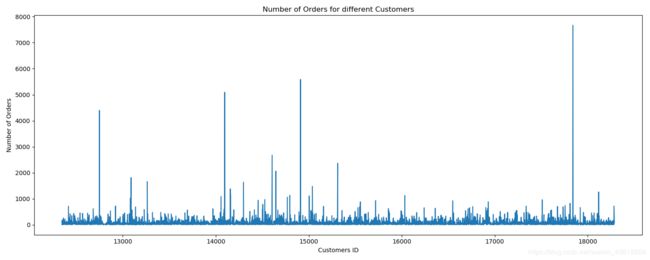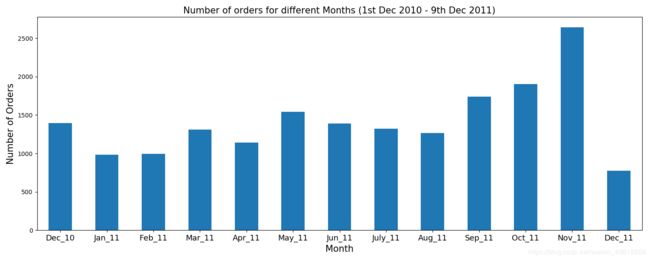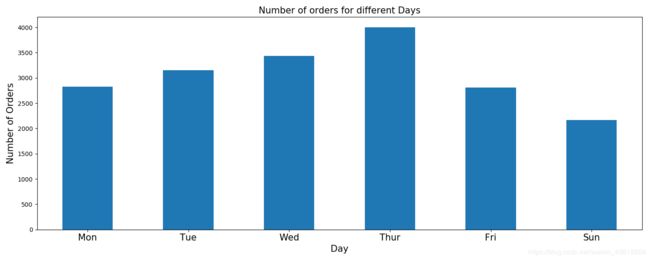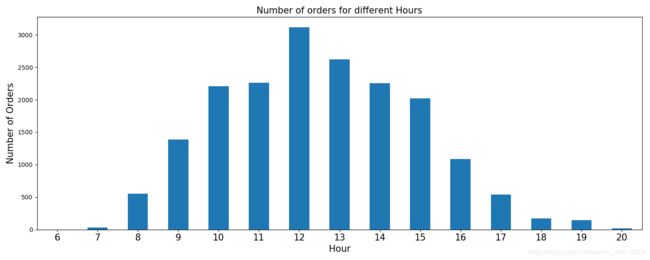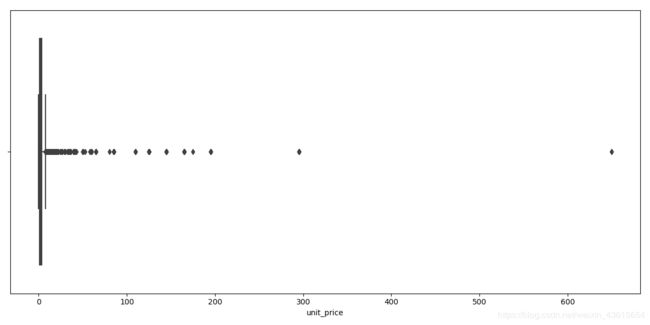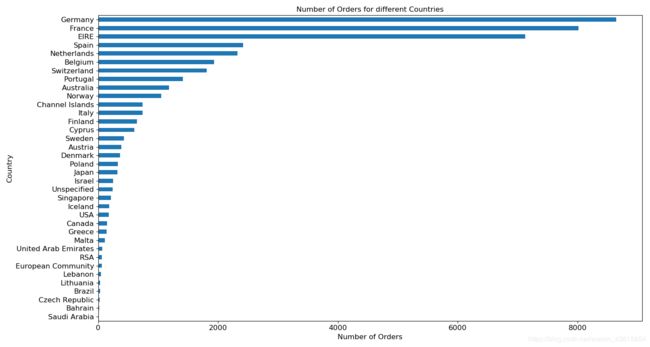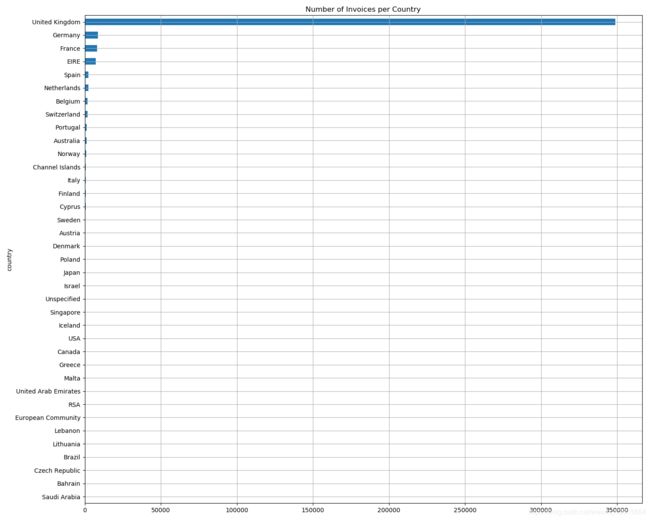kaggle上面的E-Commerce Data数据集练习(可视化与部分特征工程)
接上篇:
https://editor.csdn.net/md/?articleId=103394900
集体换个列名
data = data.rename(index=str, columns={'InvoiceNo': 'invoice_num',
'StockCode' : 'stock_code',
'Description' : 'description',
'Quantity' : 'quantity',
'InvoiceDate' : 'invoice_date',
'UnitPrice' : 'unit_price',
'CustomerID' : 'cust_id',
'Country' : 'country'})
Part 2 可视化及进一步数据分析
一种处理时间数据的方法
data.insert(loc = 2, column='year_month',value=data['InvoiceDate'].map(lambda x:100*x.year+x.month))
data.insert(loc = 3, column='month',value=data.InvoiceDate.dt.month)
data.insert(loc=4,column='day',value=(data['InvoiceDate'].dt.dayofweek)+1)## +1 to make Monday=1.....until Sunday=7
data.insert(loc=5,column='hour',value=data.InvoiceDate.dt.hour)
print(data.head())
学习点:
如何插入新行,以及其赋值方式。
时间的一些函数。
data['InvoiceDate'].map(lambda x:100*x.year+x.month))
给每一行映射,得到整型。
print(data.info())
year_month 391183 non-null int64
month 391183 non-null int64
day 391183 non-null int64
输出每一列包含多少种特征
def unique_count(data):
for i in data.columns:
count = data[i].nunique()
print(i,";",count)
unique_count(data)
OUT:
invoice_num ; 18405
stock_code ; 3659
year_month ; 13
month ; 12
day ; 6
hour ; 15
description ; 3871
quantity ; 300
invoice_date ; 17169
unit_price ; 356
cust_id ; 4335
country ; 37
一些可视化
序列特征( cust_id ),类别特征(country)和数值特征(invoice_num)的关系
orders = data.groupby(by=['cust_id','country'],as_index=False)['invoice_num'].count()
print(orders.head())
plt.subplots(figsize=(15,6))
plt.plot(orders.cust_id, orders.invoice_num)#消费者id与购买量的关系
plt.xlabel('Customers ID')
plt.ylabel('Number of Orders')
plt.title('Number of Orders for different Customers')
plt.show()
OUT:
cust_id country invoice_num
0 12346 United Kingdom 1
1 12347 Iceland 182
2 12348 Finland 27
3 12349 Italy 72
4 12350 Norway 16
print('The TOP 5 customers with most number of orders...')
print(orders.sort_values(by='invoice_num',ascending=False).head())
cust_id country invoice_num
4016 17841 United Kingdom 7667
1888 14911 EIRE 5586
1298 14096 United Kingdom 5095
334 12748 United Kingdom 4397
1670 14606 United Kingdom 2674
在类别特征下数值特征的分布
每个月多少订单?
原先的方法
out = data[['invoice_num','year_month']].groupby('year_month').count().sort_values('invoice_num', ascending=False)
根据之前的文章:Pandas的count()与value_counts()区别这里统计的其实是year_month在invoice_num里不为零值的次数。
先试试
out = data.groupby('invoice_num')['year_month'].value_counts().sort_index()
print(out)
OUT:
invoice_num year_month
536365 201012 7
536366 201012 2
536367 201012 12
536368 201012 4
536369 201012 1
Name: year_month, dtype: int64
统计不同月份卖的数量
out = data.groupby('invoice_num')['year_month'].unique().value_counts().sort_index()
作图:
ax = data.groupby('invoice_num')['year_month'].unique().value_counts().sort_index().plot('bar',figsize=(15,6))
ax.set_xlabel('Month',fontsize=15)
ax.set_ylabel('Number of Orders',fontsize=15)
ax.set_title('Number of orders for different Months (1st Dec 2010 - 9th Dec 2011)',fontsize=15)
ax.set_xticklabels(('Dec_10','Jan_11','Feb_11','Mar_11','Apr_11','May_11','Jun_11','July_11','Aug_11','Sep_11','Oct_11','Nov_11','Dec_11'), rotation='horizontal', fontsize=13)
plt.show()
可以看出,11月份销量最高。
哪天(day)卖得最好(invoice_num)?
同样的方法
ax = data.groupby('invoice_num')['day'].unique().value_counts().sort_index().plot('bar',figsize=(15,6))
ax.set_xlabel('Day',fontsize=15)
ax.set_ylabel('Number of Orders',fontsize=15)
ax.set_title('Number of orders for different Days',fontsize=15)
ax.set_xticklabels(('Mon','Tue','Wed','Thur','Fri','Sun'), rotation='horizontal', fontsize=15)
plt.show()
哪个小时(hour)卖得最好(invoice_num)?
out = data.groupby('invoice_num')['hour'].unique().value_counts()
print(out)
[12] 3117
[13] 2624
[11] 2261
[14] 2252
[10] 2204
[15] 2022
[9] 1383
[16] 1088
[8] 554
[17] 539
[18] 169
[19] 143
[7] 29
[20] 18
[6] 1
[11, 12] 1
最后一段有点问题。去掉。用iloc[:-1]。
out = data.groupby('invoice_num')['hour'].unique().value_counts().iloc[:-1].sort_index()
print(out)
[6] 1
[7] 29
[8] 554
[9] 1383
[10] 2204
[11] 2261
[12] 3117
[13] 2624
[14] 2252
[15] 2022
[16] 1088
[17] 539
[18] 169
[19] 143
[20] 18
OK,老办法画图。
ax = data.groupby('invoice_num')['hour'].unique().value_counts().iloc[:-1].sort_index().plot('bar',figsize=(15,6))
ax.set_xlabel('Hour',fontsize=15)
ax.set_ylabel('Number of Orders',fontsize=15)
ax.set_title('Number of orders for different Hours',fontsize=15)
ax.set_xticklabels(range(6,21), rotation='horizontal', fontsize=15)
plt.show()
连续值特征——价格(Unit Price)
print(data.unit_price.describe())
count 391183.000000
mean 2.874130
std 4.284639
min 0.000000
25% 1.250000
50% 1.950000
75% 3.750000
max 649.500000
Name: unit_price, dtype: float64
作一个分布图。
plt.subplots(figsize=(12,6))
sns.boxplot(data.unit_price)
plt.show()
查看免费的
data_free = data[data['unit_price']==0]
print(data_free)
订单按照国家(类别)分布
group_country_orders = data.groupby('country')['invoice_num'].count().sort_values()
plt.subplots(figsize=(15,8))
group_country_orders.plot('barh', fontsize=12)
plt.xlabel('Number of Orders', fontsize=12)
plt.ylabel('Country', fontsize=12)
plt.title('Number of Orders for different Countries', fontsize=12)
plt.show()
从上面count的用法来看,
group_country_orders = data.groupby('country')['invoice_num'].count().sort_values()
统计的是国家里的类别(UK,GERMANY…)在invoice_num出现的不为零的频次。
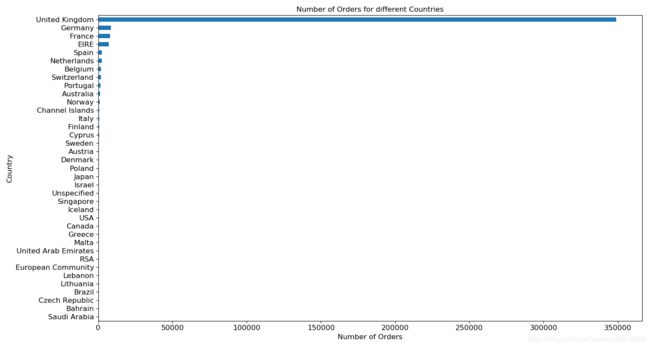
英国一骑当先。
去掉UK。画出其他国家的销量。
del group_country_orders['United Kingdom']
group_country_orders = data.groupby('country')['invoice_num'].count().sort_values()
del group_country_orders['United Kingdom']
plt.subplots(figsize=(15,8))
group_country_orders.plot('barh', fontsize=12)
plt.xlabel('Number of Orders', fontsize=12)
plt.ylabel('Country', fontsize=12)
plt.title('Number of Orders for different Countries', fontsize=12)
plt.show()
特征工程
1.总价计算
data['amount_spent'] = data['quantity']*data['unit_price']
print(data.amount_spent)
Out:
data['amount_spent'] = data['quantity']*data['unit_price']
print(data.sort_values(by='amount_spent',ascending=False).head())
invoice_num stock_code year_month month day hour description quantity invoice_date unit_price cust_id country amount_spent
540421 581483 23843 201112 12 5 9 paper craft , little birdie 80995 2011-12-09 09:15:00 2.08 16446 United Kingdom 168469.60
61619 541431 23166 201101 1 2 10 medium ceramic top storage jar 74215 2011-01-18 10:01:00 1.04 12346 United Kingdom 77183.60
222680 556444 22502 201106 6 5 15 picnic basket wicker 60 pieces 60 2011-06-10 15:28:00 649.50 15098 United Kingdom 38970.00
348325 567423 23243 201109 9 2 11 set of tea coffee sugar tins pantry 1412 2011-09-20 11:05:00 5.06 17450 United Kingdom 7144.72
52711 540815 21108 201101 1 2 12 fairy cake flannel assorted colour 3114 2011-01-11 12:55:00 2.10 15749 United Kingdom 6539.40
作图:
revenue_per_countries = data.groupby(["country"])["amount_spent"].sum().sort_values()
revenue_per_countries.plot(kind='barh',figsize=(15,12))
plt.title("Revenue per Country")
plt.grid()#画出网格线
plt.show()
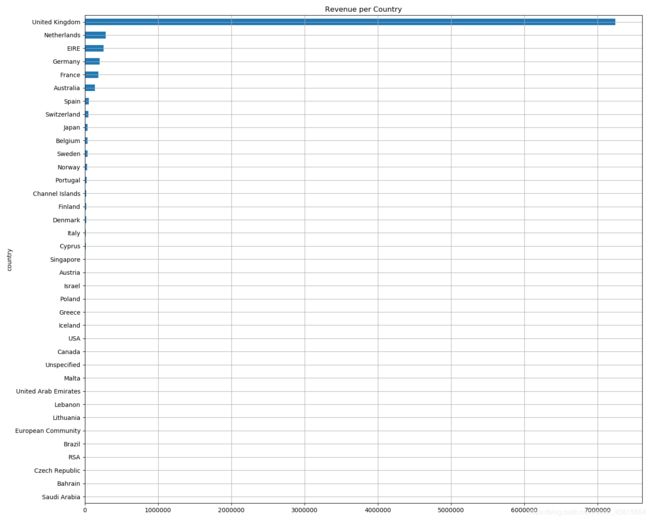
各国的购买数量(类别和数值型):
参照Pandas的count()与value_counts()区别
No_invoice_per_country = data.groupby(["country"])["invoice_num"].count().sort_values()
No_invoice_per_country.plot(kind='barh', figsize=(15,12))
plt.title("Number of Invoices per Country")
plt.grid()
plt.show()
特征工程
类别特征(‘Country’)的处理
把类别标签转换为分类数值(LabelEncoer)
le = LabelEncoder().fit(data.country)
classes = le.classes_
print(classes)
print(len(classes))
['Australia' 'Austria' 'Bahrain' 'Belgium' 'Brazil' 'Canada'
'Channel Islands' 'Cyprus' 'Czech Republic' 'Denmark' 'EIRE'
'European Community' 'Finland' 'France' 'Germany' 'Greece' 'Iceland'
'Israel' 'Italy' 'Japan' 'Lebanon' 'Lithuania' 'Malta' 'Netherlands'
'Norway' 'Poland' 'Portugal' 'RSA' 'Saudi Arabia' 'Singapore' 'Spain'
'Sweden' 'Switzerland' 'USA' 'United Arab Emirates' 'United Kingdom'
'Unspecified']
37
打上数字标签
l = [i for i in range(37)]
dict(zip(list(classes),l))
看看转换后的数字标签
country2 = pd.Series(dict(zip(list(classes),l)))
print(country2)
Australia 0
Austria 1
Bahrain 2
Belgium 3
Brazil 4
Canada 5
Channel Islands 6
Cyprus 7
Czech Republic 8
Denmark 9
EIRE 10
European Community 11
Finland 12
France 13
Germany 14
Greece 15
Iceland 16
Israel 17
Italy 18
Japan 19
Lebanon 20
Lithuania 21
Malta 22
Netherlands 23
Norway 24
Poland 25
Portugal 26
RSA 27
Saudi Arabia 28
Singapore 29
Spain 30
Sweden 31
Switzerland 32
USA 33
United Arab Emirates 34
United Kingdom 35
Unspecified 36
dtype: int64
时间特征(另一种处理方式)
使用map和lambda
data['Month'] = data['invoice_date'].map(lambda x:x.month)
data['Month'].value_counts().sort_values().plot('barh')
plt.show()
其他时间参数用同样的方式处理:
data['Month'] = data['invoice_date'].map(lambda x:x.month)
data['Weekday'] = data["invoice_date"].map(lambda x: x.weekday())
data['Day'] = data["invoice_date"].map(lambda x: x.day)
data['Hour'] = data["invoice_date"].map(lambda x: x.hour)
print(data.head())
invoice_num stock_code year_month month day hour description quantity invoice_date unit_price cust_id country amount_spent Month Weekday Day Hour
0 536365 85123A 201012 12 3 8 white hanging heart t-light holder 6 2010-12-01 08:26:00 2.55 17850 35 15.30 12 2 1 8
1 536365 71053 201012 12 3 8 white metal lantern 6 2010-12-01 08:26:00 3.39 17850 35 20.34 12 2 1 8
2 536365 84406B 201012 12 3 8 cream cupid hearts coat hanger 8 2010-12-01 08:26:00 2.75 17850 35 22.00 12 2 1 8
3 536365 84029G 201012 12 3 8 knitted union flag hot water bottle 6 2010-12-01 08:26:00 3.39 17850 35 20.34 12 2 1 8
4 536365 84029E 201012 12 3 8 red woolly hottie white heart. 6 2010-12-01 08:26:00 3.39 17850 35 20.34 12 2 1 8
